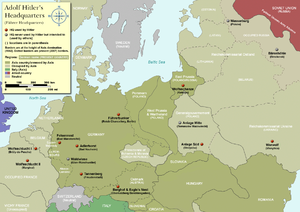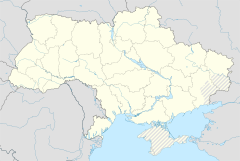Werwolf (Wehrmacht headquarters)
| Werwolf | |
|---|---|
Wehrmacht HQ | |
 Ruins of Hitler's headquarters Werwolf near Vinnytsia, Ukraine | |
| General information | |
| Type | Blast resistant concrete bunker |
| Town or city | Wervolf Forest Vinnytsia |
| Country | Ukraine |
| Coordinates | 49°18′30″N 28°29′36″E / 49.30833°N 28.49333°E |
| Elevation | 243 m (797 ft) |
| Construction started | November 1, 1941 |
| Completed | June 1942 |
| Destroyed | March 1944 |
| Owner | Third Reich |
| Technical details | |
| Structural system | Steel-reinforced concrete |
| Design and construction | |
| Architecture firm | Organisation Todt |

Führerhauptquartier Werwolf was the
Naming
The name is derived from Werwolf or Wehrwolf in German,[1] which can be translated as werewolf. The Nazis also used the term Werwolf as a codename for clandestine resistance groups which were intended to carry out guerrilla attacks against the occupying forces towards the end of World War II. The naming scheme is in accord with other code-names given to Führerhauptquartiere during the Second World War, such as Wolfsschanze. Several were named for Hitler himself, whose nickname was Wolf.[2][3][4] The site was also the easternmost Wehrmacht headquarters.
Headquarters
The complex was located in a pine forest, about 12 kilometres (7+1⁄2 miles) north of Vinnytsia in occupied Ukraine, between the villages of Stryzhavka and Kolo-Mikhailovka on the Kyiv highway. It was built between December 1941 and June 1942 under top secret conditions by Soviet prisoners of war.[5] In July 1941 the whole Vinnyts’ka oblast’ was occupied by the Nazi regime and later the entire region too. Systematic warcrimes took place in areas around where the Wehrwolf headquarter construction was; According to official figures, during the Nazi occupation of the region over 200,000 local civilians were killed, 25,000 in Vinnytsia in September 1941 and April 1942. 1,800 psychiatric patients were also shot, starved or poisoned. The Nazi regime built 18 camps for Soviet prisoners of war in the region, and several ghettos, labor camps and prisons for Jewish residents, all of whom were killed by the German occupants. Thousands of women, were sent to forced labor camps in Germany—61,000 people were removed from the Vinnytsia region to be replaced by German occupants.[6]
The location may have been influenced by the Nazis' proposed trans-European highway to the
Hitler's accommodation at Werwolf (the Führerhaus) consisted of a modest log cabin built around a private courtyard with its own concrete bunker.
There was a tea house, a barber shop, a bathhouse, a sauna, a cinema and a swimming pool, primarily intended for Hitler who never used it.[10] The facility also contained a large vegetable garden organised by the German horticultural company Zeidenspiner to provide Hitler with a secure supply of food.[10] Hitler's personal chef selected his vegetables and the food was chemically analyzed[11] before being tried by a taster because of Hitler's fear of poisoning.[12] Oxygen tanks were also available at Hitler's insistence.[13] Water for the site was provided by artesian wells while power was provided by a generator. Some historians, including Lloyd Clark, indicate that some buildings were connected by tunnels.[14]
The bunkers were constructed by Organisation Todt using some local Ukrainian workers, forced labour but mainly Soviet prisoners of war. The code name for the secret construction project was Anlage Eichenhain (Camp Oak Grove).[15] The 4000 forced laborers were lined up and shot when construction was finished.[16][17][6]
The complex was served by a daily three-hour flight connection from Berlin to the airfield in Kalinovka 20 km (12 mi) from the compound. There was also a regular train connection from Berlin-Charlottenburg to "Eichenbein" station at Werwolf.[18] The journey took 34 hours.
During Germany's Eastern campaign, Adolf Hitler lived mainly at FHQ
- 16 July to 30 October 1942: The weather was hot, up to 45 °C (113 °F), and the bunkers were humid. Hitler caught severe .
- 19 February to 13 March 1943: to observe Field Marshal Erich von Manstein's Kharkhov offensive in the wake of Germany's defeat at Stalingrad.
- 27 August to 15 September 1943: to observe the unsuccessful defense of Kharkhov.
History
The Nazis destroyed the site, including mining access to the underground complex, upon abandoning the region. The site was examined after the Nazi departure in March 1944 under the orders of Joseph Stalin, but no documentation was found. The Soviet Union took steps to permanently seal the underground parts of the complex.
Today only the swimming pool and concrete fragments remain visible on the site, which is an open recreation area.[19][20] The site can be visited but plans to create a full-fledged museum had not come to fruition as of August 2018.[5][21] Nearby is a memorial to the thousands of labourers and others buried by the Nazis in gravepits at Stryzhavka.
Photos
-
Remains of the bunker compound's swimming pool
See also
References
- ISBN 978-0765805966.
- ISBN 0-14-100131-3.
- ISBN 0-345-27385-0.
Hitler moved his headquarters to this site deep into the Ukraine [...] a few miles northeast of Vinnitsa. Christened Wehrwolf by himself, it was an uncamouflaged collection of wooden cottages and concrete bunkers, surrounded by defensive positions.
- ISBN 9781312749962.
- ^ a b Popova, Yuliya (12 March 2012). "Hitler's Ukrainian Bunker Revealed". BBC Travel. Archived from the original on 8 April 2023. Retrieved 28 August 2018.
- ^ a b Channell-Justice, Emily (2021). "Hitler's Bunker on the Eastern Front: Wehrwolf Museum Reflects Ukraine's Difficult Historical Position". Harvard Ukrainian Research Institute. Archived from the original on 13 August 2023. Retrieved 29 March 2023.
- ISBN 9781473838383.
- ISBN 978-1781593059.
- ISBN 978-0719554995.
When Hitler arrived at Werwolf Colonel Thomas, the HQ commander, was waiting for him... Thomas took Hitler over the terrain around the HQ and showed him the security measures. The area was surrounded by a defensive strip of bunkers, anti-aircraft guns and tanks, as well as anti-tank ditches and minetields. Rattenhuber Hitler's head of security, had formed a special group of RSD men whose job was to watch the approaches to the HQ and to keep an eye on the local population.
- ^ ISBN 9781312749962.
- ISBN 9781473838383.
- ^ Cohen, Claire (18 September 2014). "Last surviving female food taster, 96: 'I never saw Hitler, but I had to risk my life for him every day'". The Telegraph. Archived from the original on 13 August 2023. Retrieved 19 September 2014.
- ISBN 9781473838383.
- ISBN 978-0755336395.
- ISBN 9781846035821.
- ^ "ZED".
- ^ 'Power and Paranoia in the Third Reich', 2018, directed by Caroline Amiard
- ^ ISBN 9781312749962.
- ^ Archived at Ghostarchive and the Wayback Machine: "Adolf Hitler's Headquarters [Führerhauptquartier] Wehrwolf (Vinnytsya, Ukraine)". YouTube.
- ^ "Hitler's headquarters "Werwolf"". The Koz Telegram. 18 August 2018. Archived from the original on 29 August 2018. Retrieved 28 August 2018.
- ^ "Hitler's headquarters "Werwolf"". Discover Ukraine. 2018. Archived from the original on 6 April 2023. Retrieved 28 August 2018.
Bibliography
- Zeidler, Zeigert, Die Führerhauptquartiere.











